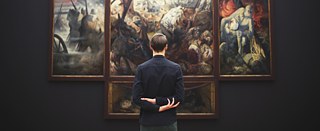The Elite in the Arts | Visual Arts
North American Painting in the Twentieth Century

In 1913, New York audiences encountered an exhibition of unprecedented scale in the United States. The vast array of artwork arranged in the enormous hall of the 69th Street Armory attracted popular attention to the latest trends in European painting.
Walt Kuhn, Walter Pach, and Arthur Davies, leaders of the recently founded Association of American Painters and Sculptors (AAPS), had traveled throughout Western Europe in 1912. They arranged loans of the latest in Impressionism, Fauvism, and Cubism, including paintings by Henri Matisse and Marcel Duchamp. The AAPS also invited U.S. artists to contribute their work. The 1913 exhibition, versions of which traveled to Chicago and Boston, featured over a thousand works of art, nearly a quarter of which were by European artists. These vanguard paintings were familiar to an elite group of North American artists and collectors who had traveled in Europe, but surprised many U.S. viewers and caused a public outcry. For example, newspapers caricatured Marcel Duchamp’s cubo-futurist Nude Descending a Staircase by likening it to rush hour on the subway or sunrise in a lumberyard; even President Theodore Roosevelt compared it unfavorably to a Navajo rug in his bathroom. Although popular audiences reacted with humor to art they perceived as elite, the Armory Show nonetheless became a landmark in popularizing modern
painting in the U.S.

Following World War I, an increasing number of North American painters and art viewers began to imagine ways that art might be derived domestically from the United States rather than from European avant-gardes. During the 1930s and 1940s, federally funded New Deal programs established to fight the economic depression put artists to work on public projects across the nation, including murals and easel paintings. New photo magazines brought arts coverage into homes in every corner of the country. A Time magazine cover in 1934, for example, featured a self-portrait by Thomas Hart Benton who, along with Grant Wood and John Steuart Curry, formed a loose alliance known as the American Regionalists. While some lauded their depictions of the rural landscape and hardworking inhabitants of America’s agricultural heartland, other artists and art critics deemed Regionalist painting dangerous, regarding its popular, easily understood realism as a vehicle for jingoism and even fascism.
U.S. painting of the immediate postwar era became dominated by what has come to be known as Abstract Expressionism. In 1955 the critic Clement Greenberg published American-Type Painting, championing Jackson Pollock and other abstract painters as elite, avant-garde modernists who focused on specific qualities of painting, including flatness, which differentiated it from other art forms. This late modernism often positioned painting as an autonomous art closed off from everyday life, but in 1951 Pollock’s paintings were also used as the backgrounds for fashion photography in Vogue.
Within the U.S., the 1960s and 1970s witnessed rising elite art world interests in non-painterly art forms, including post-modern photography, installation, video, and performance art. Many critics pondered the so-called “death” or end of painting. The 1980s, however, signaled a renewed interest in contemporary U.S. painting when art historian and art critic Barbara Rose organized the forward-looking traveling exhibition American Painting: The Eighties (1979) and the Whitney Museum biennial, often seen as an elite bellwether, emphasized Neo-Expressionist and figurative painting in 1981.
To the Overview